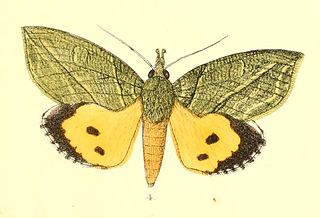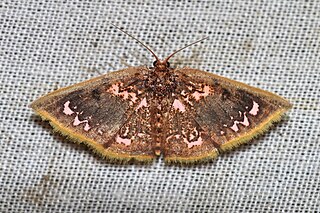
Eurema hecabe, the common grass yellow, is a small pierid butterfly species found in Asia, Africa and Australia. They are found flying close to the ground and are found in open grass and scrub habitats. It is simply known as "the grass yellow" in parts of its range; the general term otherwise refers to the entire genus Eurema.

Jamides celeno, the common cerulean, is a small butterfly found in Indomalayan realm belonging to the lycaenids or blues family. The species was first described by Pieter Cramer in 1775.

Hypolimnas misippus, the Danaid eggfly, mimic, or diadem, is a widespread species of nymphalid butterfly. It is well known for polymorphism and mimicry. Males are blackish with distinctive white spots that are fringed in blue. Females are in multiple forms that include male-like forms while others closely resemble the toxic butterflies Danaus chrysippus and Danaus plexippus.

Curetis bulis, the bright sunbeam, is a species of butterfly belonging to the lycaenid family. It is found in Asia.

Vindula erota, the common cruiser, is a species of nymphalid butterfly found in forested areas of tropical South Asia and Southeast Asia.

Dordura is a monotypic moth genus of the family Noctuidae erected by Frederic Moore in 1882. Its only species, Dordura aliena, was first described by Francis Walker in 1865. It is found in the Indian subregion, Sri Lanka, Myanmar, Thailand, Peninsular Malaysia, Sumatra, Borneo and New Guinea.

Thyas coronata is a species of moth of the family Erebidae first described by Johan Christian Fabricius in 1775. It is found from the Indo-Australian tropics of southern China, Taiwan, Japan, Nepal, India, Sri Lanka to Micronesia and the Society Islands.

Phyllodes consobrina is a noctuoid moth in the family Erebidae and subfamily Calpinae. It was first described by John O. Westwood in 1848. The species can be found in Asia, including Thailand, Sri Lanka, Bangladesh, the Andamans and India.
Ulotrichopus rama is a moth of the family Erebidae first described by Frederic Moore in 1885. It is found on Sumatra, Flores and Sri Lanka.

Eudocima homaena is a moth of the family Erebidae first described by Jacob Hübner in 1816. It is found in the Indian subregion, Sri Lanka, Myanmar, Taiwan, the Nicobars, Peninsular Malaysia, Borneo, the Philippines and on Christmas Island. It is a major pest on orange plants.

Eudocima hypermnestra is a moth of the family Erebidae described by Pieter Cramer in 1780. It is found in China, Thailand, Taiwan, India and Sri Lanka.

Eudocima salaminia, the green fruit-piercing moth, is a moth of the family Erebidae. The species was first described by Pieter Cramer in 1777. It is found from India, and across south-east Asia to the Pacific Islands. In Australia it occurs in the Northern Territory, Queensland and New South Wales. The adult is a fruit piercer.

Catochrysops strabo, the forget-me-not, is a small butterfly found in Asia that belongs to the lycaenids or blues family. The species was first described by Johan Christian Fabricius in 1793. It is found in Sri Lanka, India, from Sikkim to Indochina and in Sundaland, Sulawesi and the Philippines.

Cosmopterix harpalyke is a moth of the family Cosmopterigidae. It is known from the Federal District of Brazil.

Ischyja manlia is a species of moth of the family Noctuidae first described by Pieter Cramer in 1776. It is found in the Indian subregion, Sri Lanka, Myanmar, Thailand, China, Okinawa, Sundaland, Sulawesi, Korea, the southern Moluccas, Australia (Queensland) and Palau.

Hyblaea constellata is a moth in the family Hyblaeidae first described by Achille Guenée in 1852. It is found in India, Sri Lanka, south-east Asia, including China, Japan, Taiwan, Myanmar and Thailand. It is also found in Queensland, Australia.

Spilosoma fumida is a species of moth of the family Erebidae. It was described by Alfred Ernest Wileman in 1910. It is found in Taiwan.
Lemyra subfascia is a moth of the family Erebidae. It was described by Francis Walker in 1855. It is found in Sri Lanka.
Calamotropha atkinsoni is a moth in the family Crambidae. It was described by Philipp Christoph Zeller in 1863. It is found in south-east Asia, where it has been recorded from India, Sri Lanka, Thailand, Singapore and Sulawesi.

Chrysocraspeda abhadraca is a species of moth in the family Geometridae described by Francis Walker in 1861. It is found in Indian subregion including India and Sri Lanka, Peninsular Malaysia, Sumatra and Borneo.
















